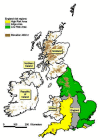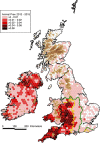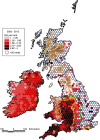Further description of bovine tuberculosis trends in the United Kingdom and the Republic of Ireland, 2003-2015
- PMID: 30487295
- PMCID: PMC6312888
- DOI: 10.1136/vr.104718
Further description of bovine tuberculosis trends in the United Kingdom and the Republic of Ireland, 2003-2015
Abstract
Extending on earlier work, trends in bovine tuberculosis (bTB) from 2003 to 2015 are described for the countries of the UK and the Republic of Ireland using standardised definitions and measures. Based on measures of animal and herd incidence, there remains a stable situation of extremely low prevalence in Scotland and the Low Risk Area of England, and a higher but ongoing reduction in prevalence in the Republic of Ireland. In Northern Ireland, there has been a rising bTB trend during 2010-2015, although not to levels experienced during 2002-2004. In the High Risk Area and Edge Area of England during 2010-2015, the rising bTB trends have continued but with some recent evidence of stabilisation. In Wales, prevalence has fallen subsequent to a peak in 2008. The paper considers country-level differences in the light of key policy changes, which are presented in detail. This work is unique, and will assist policymakers when critically evaluating policy options for effective control and eradication. Ongoing updates of this analysis would be useful, providing an evidence base for country-level comparison of bTB trends into the future. The use of multivariable analytical methods should be considered, but will rely on substantial sharing of raw data across the five countries.
Keywords: Republic of Ireland; United Kingdom; bovine tuberculosis; epidemiology; eradication.
© British Veterinary Association 2018. Re-use permitted under CC BY-NC. No commercial re-use. Published by BMJ.
Conflict of interest statement
Competing interests: None declared.
Figures



















References
-
- HEALTH PROTECTION SURVEILLANCE CENTRE. (2010) Guidelines on the prevention and control of tuberculosis in Ireland 2010 (amended 2014). https://www.hpsc.ie/a-z/vaccinepreventable/tuberculosistb/publications/F....
-
- ANON. Council Directive 64/432/EEC of 26 June 1964 on animal health problems affecting intra-Community trade in bovine animals and swine. Official Journal of the European Communities;1964:121:164–84 https://eur-lex.europa.eu/legal-content/EN/LSU/?uri=CELEX:31964L0432.
MeSH terms
LinkOut - more resources
Full Text Sources

